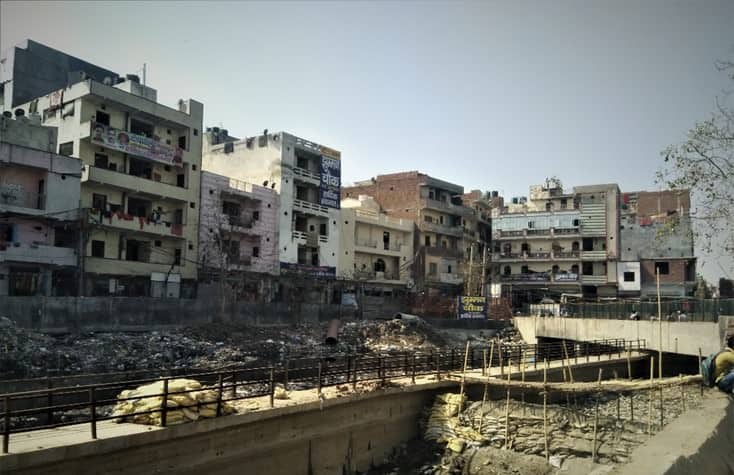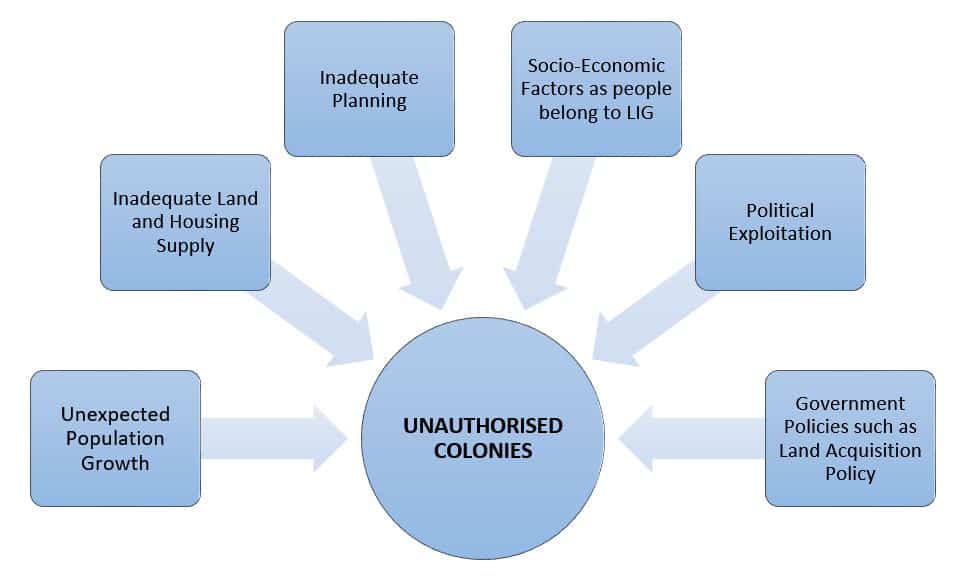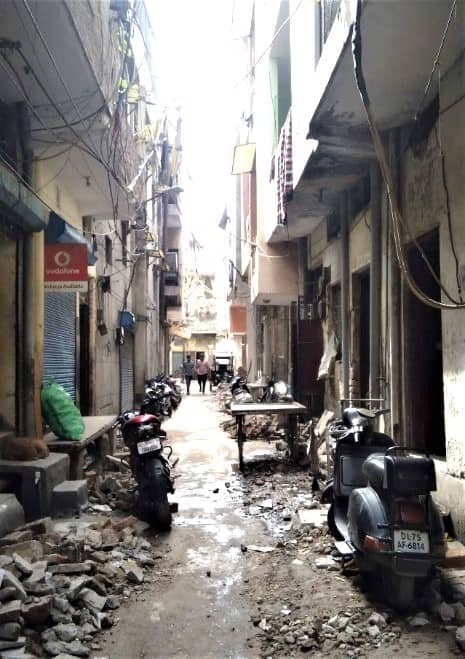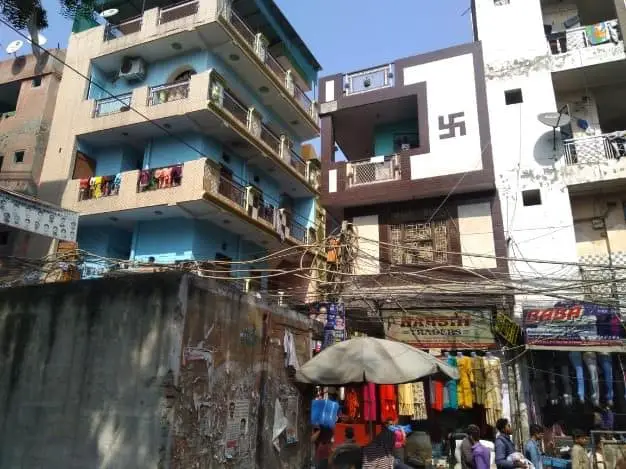Concept of Unauthorized Colonies
Sweltering weather, barren roads with no sign of political campaigning. This is the first look that a visitor gets while visiting the Bhalaswa Dairy, a cluster of unauthorised colonies in the North West Delhi Lok Sabha Constituency. (Kaushal, 2019) .The Ghadauli Extension in North Delhi, a place where the government gave land to milkmen on rent for Rs.4 per cattle during early 1980s. This was done to keep the dairy business out of the city and to avoid chaos in the city. Such a phenomenon kept on increasing the number of buildings in the area and ultimately giving a rise to the unauthorised colonies.

Figure 1 :Condition of Unauthorised Colony in Old Seelampur near Shahdara drain, Delhi Image Source: Parmesh Kumar
“Unauthorised Colony” means a colony or development comprising of a contiguous area, where no permission has been obtained for the approval of layout plan or building plans and has been identified for regularisation of such colony in pursuance to the notification number S.O. 683(E) dated the 24th March, 2008 and includes colonies as identified by the Delhi Development Authority under these regulations. (Justice, 2019) The term unauthorised colonies are given by the Delhi Development Authority (DDA), to those residential colonies that have grown in Delhi over the past twenty years, without DDA’s legal approval and without adhering to the rules of city’s master plan.
Related Articles:
- Delhi Master Plan 2021 by Delhi Development Authority (DDA)
- What is Land Pooling?
- What are Unauthorised Colonies? | Categories, Reasons of Formation, Problems Faced
Unauthorised Colonies vs JJ Clusters
Unauthorised colonies (UACs) are often confused with Jhuggi Jhopri (JJ) Clusters. These are, however, two distinct types according to the seven categories of ‘unplanned’ settlement defined by the Government of National Capital Territory of Delhi (GNCTD). A JJ Cluster is located on “public land”—land owned by a public agency such as the Delhi Development Authority (DDA), Railways, Central Public Works Department (CPWD), or a department or agency of the GNCTD or the MCD. Unauthorised Colonies on the other hand, is located on land zoned for a non-residential purpose especially agricultural land. Residents of unauthorised colonies enjoy slightly more secure land tenure than those of JJ Clusters. It is often considered that unauthorised colonies are not perceived as “encroachments” like JJ Clusters, but they are also not considered to be part of the ‘planned’ city.
Evolution of Unauthorized Colonies
Migration coupled with natural increase in the population and exorbitant market forces for housing accommodation has given rise to UACs. Located on the urban fringe, often on environmentally fragile lands, lacking infrastructure and services. It makes a substantial contribution to housing stock and is a rapidly expanding form of housing stock supply. The land owners whose land came in the urban limits of the city subdivided them and sold them to public directly. This helped them escape from the acquisition from the government authorities.
Case of Delhi
The DDA is responsible for all the development since 1957 in the city of Delhi and is supposed to own all land within the planned and projected urban limits of the city. Delhi or the National Capital Territory (NCT) is a megacity with the population of more than 19 million and geographical area of 1484 sq.km. The existence of the phenomenon of unauthorized colonies in Delhi was several years before the independence period: right form the year 1911, when Delhi became the capital city of India under the colonial rule. The increase in population put high pressure on land and housing and other urban services increasing the demand for them much more than supply. The construction labourers in 1930s industrialization in 1940s refugee influx in 1947 have been the premier causes to accelerate the rate of migration into Delhi. In 1951, unauthorized colonies contributed 11% of the housing stock in Delhi. In the immediate post-independence period, illegal land subdivision and later was being carried out mainly by petty developers. In 1962, Delhi had only 110 unauthorised colonies, built-in contravention of zoning regulations, where some two lakh people lived. (Anand, 2019)
Factors Responsible for the Emergence and Proliferation of Unauthorized Colonies
The unauthorised colonies are not formed under one or two circumstances rather there is a queue of factors responsible for it. The Unexpected Population Growth in 1947 (due to Refugee Reflux) caused significant mismatch between the actual demand for land & housing and the proposed supply of these commodities. Therefore, continuous migration from other parts of country increased the land prices. Monopolistic role of public sector in land development since 1959 and exclusion of private sector seems another factor for proliferation of unauthorized colonies. Due to this there was an increase in exclusion of low income groups due to high cost of land and housing. No fulfilment of immediate need for housing and significant delays in housing projects of a significant number of people forced them to live in unauthorised colonies as the land was affordable and accessible.
At the same time the planning of cities was not as in demand as of now. The Inadequacy in Planning led to haphazard development and lack of monitoring increased the development in these illegal areas. Cheap land in unauthorized colonies attracted wise upper and middle income people to exploit the situation. Emergence of unauthorised colonies during the election periods, under political patronage providing an umbrella against any administration action, in return for political supports is a prevalent issue of our country.

Figure 2: Factors responsible for Increase in Unauthorized Colonies collected from various sources
Deficiencies and Issues in Unauthorized Colonies
Deficiencies in settlement level includes narrow streets which leads to difficulty in movement pattern, irregular street patterns with plots of different shapes and sizes, bad conditions of roads leading to difficulty in walking during rainy seasons, and small industrial units operating in residential areas which further creates nuisance for residents.

Figure 3 : Narrow Lane in Ghondli Urban village of Krishna Nagar Area in Delhi, Image source: Parmesh Kumar
If we analyse the plot level the deficiencies include the plot without setbacks, or sometimes plots touching the walls on three sides of different plots, no provision of ventilation or fresh air, existent of different typologies existing together, rooms sizes are extremely small, basement are sometimes used for industrial activities.
The development of unauthorised colonies is entirely dynamic and fluid. There is a high stress on Physical Infrastructure – Electricity, increase in electric meter connection leading to increase in load on transformer. There are no building height restrictions, builders go for a structure up to G+4 storey without taking any permission or following any structure related norms. There is deterioration of quality of life in various terms. The hanging High Tension wire and Electric poles are a cause of accidents and fire in the building.

Figure 4 : Hanging wires, housing conditions in Gandhinagar Area, East Delhi district, Image Source: Parmesh Kumar
The issues such as garbage littered on roads, unhygienic public toilets, etc. are common in the areas apart from sanitation and basic amenities the issue of ownership over land is another issue that disturbs the residents of the colonies. Reports suggest that people living here cannot take loan against their property and this is where regularisation assumes a significance in the long debated issue.
Related Articles:
- What is a Slum?
- Why Transit Oriented Development Policy of Delhi Should Focus on Non-Motorized Transport
- NCR Regional Plan – National Capital Region 2021 | India
Conclusion
The question that triggers our mind today is that “Why are these colonies unauthorised even when their value is in crores?” At present, there are 1,797 identified unauthorised colonies spread over 175 square-km of the national capital inhabited by 45 lakh people approximately from lower income groups. The people living in these colonies are deprived from the ownership rights. They are lacking basic infrastructure in terms of piped water supply, sewerage connections, road construction and other infrastructure. The Government of India recently passed a notification to regularise 1731 UAC’s catering almost 40 Lakh population. Delhi Lieutenant Governor approved the registrations and conferring ownership rights for the residents of unauthorised colonies under the Prime Minister Unauthorised Colonies in Delhi Awas Adhikar Yojna (PMUDAY).
These colonies developed mainly on agricultural land which were owned by local landowners and government land. Therefore, indiscriminate construction became a major problem in regularisation. If such colonies are regularised, the residents will be able to transfer/sell their properties, avail of home loans and be eligible to demand basic amenities such as water and electricity. (Times, 2019) It is quite obvious therefore, that this dynamic, fluid and sometimes even unplanned development can result in the creation of urban sprawl, when cities expand rapidly with little concern for the provision of infrastructure or the lifestyle of its residents.
About the Authors
Author: Parmesh Kumar has done B.Arch. from Faculty of Architecture, UPTU, Lucknow and completed his Masters in Urban and Rural Planning (MURP) from IIT Roorkee. He is currently working as a Fellow at Delhi Assembly Research Centre, Delhi Legislative Assembly.
Co-Author: Srishti Singh has done B.Arch. from Ansal Technical Campus, Lucknow and currently pursuing her Masters in Planning from Department of Regional Planning, School of Planning and Architecture (SPA), New Delhi.
References:
- Anand, A., 2019. Regularisation of unauthorised Delhi colonies: A massive infra and realty revamp, New Delhi: India Today.
- Justice, M. o. L. a., 2019. The National Capital Territory of Delhi (Recognition of Property Rights of Residents in Unauthorised Colonies) Act, 2019, New Delhi: The Gazette of India.
- Kaushal, R., 2019. Land Regularisation Remains Key Factor for Residents of Delhi’s Unauthorised Colonies, New Delhi : News Click.
- Times, H., 2019. Here’s how residents of Delhi’s unauthorised colonies can apply for ownership rights, New Delhi: Hindustan Times.
- Ansari, J.H., June 1992, 10(4), 1992, 150, Unauthorized Development: Issues and Strategies-Delhi, ITPI Journal, New Delhi.
- Ahmad, S., Sridharan N., Kono, N., 2012, Housing Supply System in Unauthorised Settlements in Delhi: Process and Outcomes, Unauthorised Settlements in Delhi, 48th ISOCARP Congress.
- Centre for Policy Research, April 2014. Report on Regularizing Delhi’s Unauthorised Colonies.
- Ministry of Housing and Urban Affairs Notification, 29th October 2019, New Delhi, The Gazette of India: Extraordinary
- Government of NCT of Delhi, Department of Urban Development, Unauthorized Colonies Cell, 2018, viewed 8th June 2020, http://health.delhigovt.nic.in/wps/wcm/connect/doit_udd/Urban+Development/Our+Services/Unauthorized+Colonies+Cells+%28UC%29/
- Delhi development Authority, Unauthorized Colonies, 2011, viewed 8th June 2020,